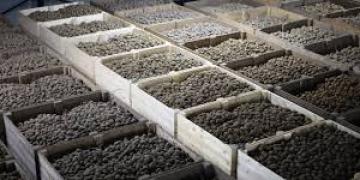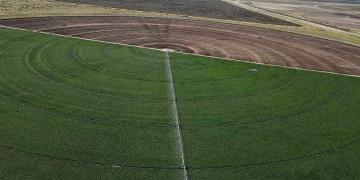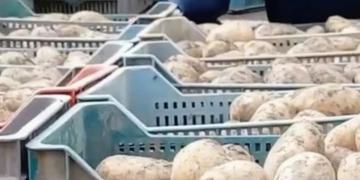Argentina (Patagonia): Potato cultivation with pivot irrigation is advancing in arid regions
In Carmen de Patagones and Luis Beltrán, Martín Pasman farms land that was once arid. As in other provinces, he rotates crops, placing potatoes at the heart of his business.

In northern Patagonia, one of Argentina’s largest potato producers decided to put down roots. Martín Pasman, an agronomist and fifth-generation member of a family with deep roots in agriculture, has spent decades developing high-yield agricultural projects in various provinces across the country. But it is in the Lower and Middle Valleys of the Río Negro where he found the ideal setting to combine technology, efficiency, and productive development.
So much so that almost half of his potato production is concentrated between Carmen de Patagones (Buenos Aires) and Luis Beltrán (Río Negro), where he also grows onions, wheat, and corn using a precision irrigation system that transforms arid soils into fertile fields. From his perspective as both a producer and technician, he describes himself as passionate about "transforming one cow per 20 hectares" in intensive agriculture, convinced that the future of Argentine agriculture lies in irrigation and bringing currently desert areas into production.
A potato giant takes advantage of the Negro River
Martín Pasman’s potato business is of considerable scale: he manages around 90 irrigation pivots distributed across Córdoba, San Luis, southern Buenos Aires, and the Río Negro basin. He produces potatoes year-round for fresh consumption and to supply the three potato chip manufacturers in Argentina: McCain (in Balcarce), Simplot (in Mendoza), and Lamb Weston (in Mar del Plata).
“We supply the market every month of the year. While we’re planting in one place, we’re harvesting in another,” he summarizes. This strategy allows him to meet the constant demand for an essential food. In Patagones and Beltrán, for example, he plants between September and October and harvests from January to June. From there, he supplies the entire country, especially the Patagonian provinces, with potatoes of outstanding quality.
Of the 3,000 hectares he dedicates to potatoes, around 50% are located in the Río Negro basin. In Carmen de Patagones, his own farm, “El Carbón,” has a total of 1,750 hectares under irrigation with 23 center pivots. In Luis Beltrán, he produces on a 1,000-hectare plot leased from McCain, irrigated with 20 active center pivots. “I started between Córdoba and Buenos Aires, but then I began to look south,” he recalls. His first visit to the valley in the 1990s was enough to leave him “fascinated by the river and by everything that could be done with irrigation.” Since then, his commitment to the south has only strengthened: “Today, half of our potato business is along the Río Negro,” he states, looking at the dust kicked up by the Patagonian wind and the potato planting machines.
The yields support that decision. In both fields, he achieves between 55 and 60 tons of potatoes per hectare. That, combined with his large scale, places him among the most efficient producers in the country.
Potatoes in Patagonia: efficiency and sustainability with technology and management
The foundation of Pasman’s system is center-pivot irrigation, a method he knows intimately and defends with conviction. "It’s the system best suited to extensive crops. It allows for great operational efficiency; we manage everything via telemetry, from a computer or a phone, with 90% efficiency and very low labor requirements," he explains.
His relationship with the Valley company (of which he is president in Argentina and through which he participated in the development of projects in Río Negro) reinforces this choice. Each field has its own weather stations, which measure temperature, humidity, radiation, and wind to precisely adjust irrigation. “We calculate the water balance like a bank account: how much the crop takes out and how much we’re giving it. Everything is very carefully measured because water is a scarce resource and irrigation is expensive.”
In each potato cycle, he applies between 800 and 900 millimeters of water, regulating the rate according to the crop’s evapotranspiration. “With the pivot irrigation system, we can be very precise. We apply the amount of water the soil can retain, without excess,” he explains. In his production system, each field has soil maps and a schedule adjusted by sector, which allows him to irrigate more slowly in sandy areas and more quickly in clay soils.
Agronomic management is also designed to sustain productivity. The typical rotation is potato, wheat, onion, wheat, potato, wheat, wheat, potato. “We grow less onion, more potatoes. If you take a satellite image of the fields, you’ll see 25% potatoes, 50% wheat, 12.5% onions, and 12.5% corn,” he explains. The wheat produced in both locations is exported via Bahía Blanca, while the corn is sold locally to feedlots in the region . Yields average 14,000 kilos per hectare for corn and 7,000 for wheat.
Regarding potato varieties, Spunta stands out for fresh consumption (with a thin, smooth, and light-colored skin), while Innovator, for industrial use, has a higher dry matter content. “One has 20% dry matter, the other 16%. Spunta is the one we eat every day; Innovator is more reticulated and has a thicker skin, but it’s excellent fried. Gnocchi made with that potato is a dream,” he remarks with both technical and culinary enthusiasm.
Develop with irrigation in the desert
Beyond its scale and technology, Pasman is defined by a vocation: developing farmland. “I love transforming ’one cow per 20 hectares’ into 60 tons of potatoes per hectare, or 14,000 kilos of corn per hectare. Argentina has enormous potential for transformation through irrigation,” he maintains. His preference for desert areas is no coincidence: all his productive fields are located in places that receive less than 500 millimeters of rain per year. “If I don’t irrigate, I don’t produce anything. But I like producing this way. I like seeing how irrigation changes everything,” he affirms.
That perspective explains his commitment to the Río Negro basin, a territory he considers to have enormous potential. “This region has everything it needs to develop: available water, suitable soils, and a favorable climate. With crop rotation, no-till farming, and irrigation, it can be completely transformed,” he asserts.
From his farm on the north bank of the river, Pasman combines the vision of an engineer with the passion of a farmer. While continuing to expand his irrigation system and rotate crops, he insists that the future of Argentine agriculture lies in using water wisely. “With irrigation, any area can change its productive destiny. You just have to be willing to develop it,” he concludes.
Fuente: Río Negro Newspaper




